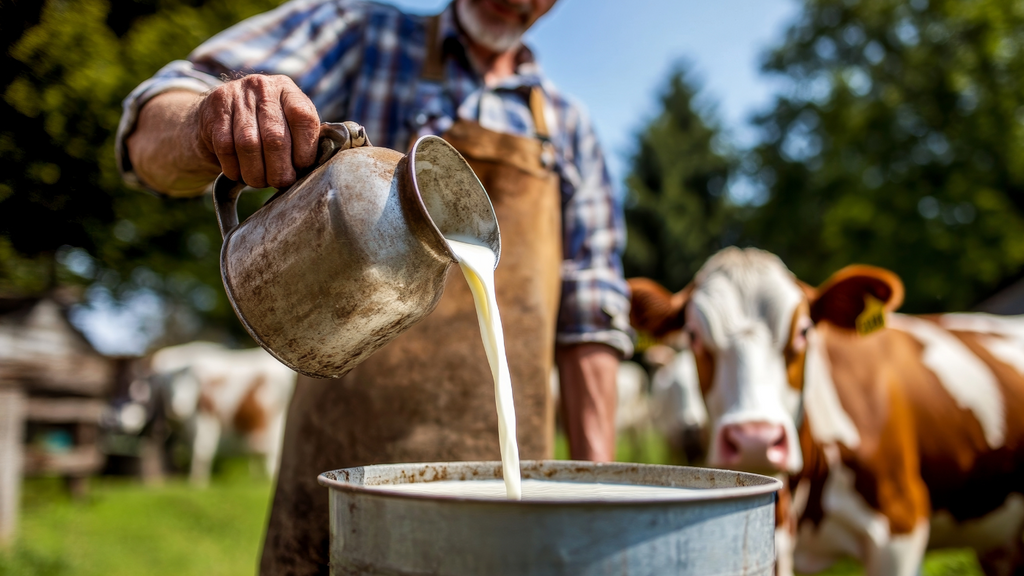They told you it was unhealthy and dangerous, but they failed to give you the full picture…
Mandatory pasteurization wasn’t about safety—it was a money-making scheme to funnel small, family farms into costly machinery, pushing many out of business from generational land.
The mainstream message blamed raw milk… but back then, cows were often raised in filthy, crowded conditions. The cows were the problem—not the raw milk.
Today, we know raw milk from healthy, well-raised cows is a health food. It’s packed with vitamins, minerals, and gut-friendly probiotics—virtually annihilated by pasteurization.
Raw milk is a powerhouse: loaded with calcium, iodine, zinc, magnesium, B vitamins, retinol (vitamin A), vitamin D3, vitamin E, vitamin C, and bioavailable protein—essentially giving your body everything it needs.
Choose organic, grass-fed, raw A2 milk from healthy cows… and you’ll never look back.
1. The World’s Best Soccer Player Drinks Raw Milk…

Imagine Cristiano Ronaldo trading Gatorade for a chilled glass of raw milk—sounds wild, but it’s the kind of bold, primal energy we’re talking about. The point? Raw milk has always been framed as fringe. Meanwhile, elite performers—back in the day—understood it delivered real, sustainable power. It was shunned publicly, while quietly fueling legends. Let your hero shot be your glass: raw, unfiltered energy.
2. You Can Buy Roundup in All 50 States … but Raw Milk Is Illegal in 18 of Them

Think about that: toxic herbicides are anywhere from hardware stores to big-box aisles, yet something as natural as milk from grass-fed cows is banned outright in over a third of states. That contrast tells you who’s winning the narrative war. The law allows the unnatural and bans the natural. That is not progress—it’s propaganda.
3. Milk Left Out of the Fridge: Raw Turns into Yogurt Full of Probiotics, Pasteurized Milk Grows Mold

Leave a jug of raw milk on your counter overnight—it naturally ferments into tangy, probiotic-rich yogurt. Let pasteurized milk sit? Mold city. Raw milk is alive; it's an ecosystem that supports gut health. Pasteurized milk is lifeless. No wonder savvy grandparents once left cream on the windowsill—this was the original, unadulterated fermentation in action.
4. Look at What Pasteurizing Milk Does to Its Nutrient Content

Heat kills off more than pathogens—it clobbers nutrients too. Meta-analyses show pasteurization reduces B vitamins (B₁, B₂), vitamin C, and folate.proponents claim minimal impact, these vitamins matter—especially B₂, where milk is a major dietary source. You’re sacrificing real nutrition for questionable safety—especially when raw milk from healthy animals is carefully produced.
5. Raw Milk’s Nutrient Powerhouse: Zinc, Retinol, D₃, Hormones, Gut Health, Thyroid (Iodine), Muscle Mass, Energy, Antioxidants, Bone Health

Raw milk is like nature’s multivitamin in liquid form. It delivers healing minerals like zinc and iodine, daily doses of fat-soluble vitamins A, D₃, and E, plus energy-boosting proteins and antioxidants. It supports thyroid function, muscle growth, and bone strength—fuel that keeps the body firing on all cylinders. It’s nutrition the way nature intended—which no ultra-processed alternative can replicate.
Closing Paragraph
So, let’s cut through the noise: raw milk isn’t the villain—it’s the victim of industrial profit margins and fear-based messaging. Pasteurization may prevent some risks, but at what cost? Lesser nutrition, industrial consolidation, and the loss of ancestral food wisdom. Choose wisely: go organic, grass-fed, raw A2. Let your body thank you with vitality and clarity that pasteurized products simply can’t match.
Works Cited
- Loss, Georgina, et al. “The Protective Effect of Farm Milk Consumption on Childhood Asthma and Atopy: The GABRIELA Study.” Journal of Allergy and Clinical Immunology, vol. 128, no. 4, 2011, pp. 766–773. doi:10.1016/j.jaci.2011.07.048.
- Lluis, Albert, et al. “Protection Against Respiratory Infections by Early-Life Farm Exposure: The PARSIFAL and GABRIELA Studies.” Journal of Allergy and Clinical Immunology, vol. 137, no. 2, 2016, pp. 627–635. doi:10.1016/j.jaci.2015.07.048.
- Waser, Mario, et al. “Inverse Association of Farm Milk Consumption with Asthma and Allergy in Rural and Suburban Populations across Europe.” Clinical and Experimental Allergy, vol. 37, no. 5, 2007, pp. 661–670. doi:10.1111/j.1365-2222.2006.02640.x.
- Alfvén, Tobias, et al. “Consumption of Unprocessed Cow’s Milk Protects Infants from Common Respiratory Infections.” The Journal of Allergy and Clinical Immunology, vol. 133, no. 5, 2014, pp. 1371–1379. doi:10.1016/j.jaci.2013.10.046.
- Raw Milk Institute. “Letter to Medical Professionals about Raw Milk.” Raw Milk Institute, 2023, www.rawmilkinstitute.org/updates/letter-to-medical-professionals-about-raw-milk.
- Macdonald, L. E., et al. “A Systematic Review and Meta-Analysis of the Effects of Pasteurization on Milk Vitamins, and Evidence for Raw Milk Consumption and Other Health-Related Outcomes.” Journal of Food Protection, vol. 74, no. 11, 2011, pp. 1814–1832. doi:10.4315/0362-028X.JFP-11-196.

